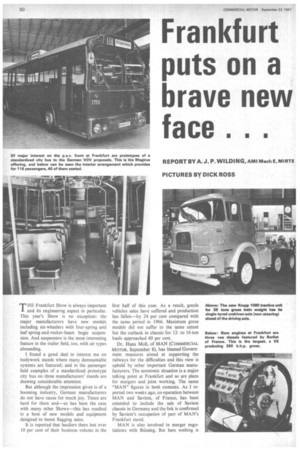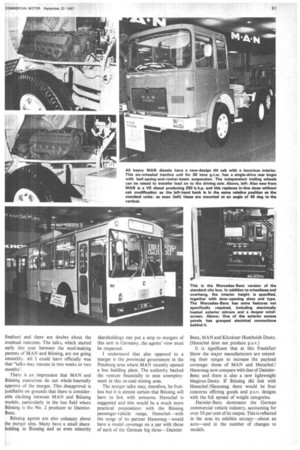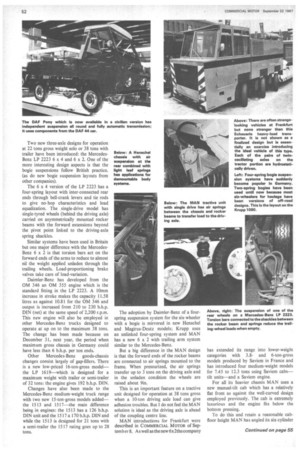Frankfurt puts on a brave new
Page 52

Page 53

Page 54

Page 57

If you've noticed an error in this article please click here to report it so we can fix it.
face...
THE Frankfurt Show is always important and its engineering aspect in particular. This year's Show is no exception; the major manufacturers have new models including six-wheelers with four-spring and leaf-spring-and-rocker-beam bogie suspension. And suspension is the most interesting feature in the trailer field, too, with air types abounding.
I found a good deal to interest me on bodywork stands where many demountable systems are featured; and in the passenger field examples of a standardized prototype city bus on three manufacturers' stands are drawing considerable attention.
But although the impression given is of a booming industry, German manufacturers do not have cause for much joy. Times are hard for them and—as has been the case with many other Shows—this has resulted in a host of new models and equipment designed to boost flagging sales.
It is reported that hauliers there lost over 10 per cent of their business volume in the first half of this year. As a result, goods vehicles sales have suffered and production has fallen—by 24 per cent compared with the same period in 1966. Maximum gross models did not suffer to the same extent but the cutback in chassis for 12to 16-ton loads approached 40 per cent.
Dr. Hans Moll, of MAN (COMMERCIAL MOTOR, September 8), has blamed Government measures aimed at supporting the railways for the difficulties and this view is upheld by other important German manufacturers. The economic situation is a major talking point at Frankfurt and so are plans for mergers and joint working. The name "MAN" figures in both contexts. As I reported two weeks ago, co-operation between MAN and Saviem, of France, has been extended to include the sale of Saviem chassis in Germany and the link is confirmed by Saviem's occupation of part of MAN's Frankfurt stand.
MAN is also involved in merger negotiations with Bilssing. But here nothing is
finalized and there are doubts about the eventual outcome. The talks, which started early this year between the steel-making parents of MAN and Bussing, are not going smoothly. All I could learn officially was that "talks may resume in two weeks or two months-.
There is an impression that MAN and Bussing executives do not whole-heartedly approve of the merger. This disapproval is justifiable on grounds that there is considerable clashing between MAN and BUssing models, particularly in the bus field where Missing is the No. 2 producer to DaimlerBenz.
Btissing agents are also unhappy about the merger idea. Many have a small shareholding in Bussing and as even minority shareholdings can put a stop to mergers of this sort in Germany, the agents' view must be respected.
I understand that also opposed to a merger is the provincial government in the Pensburg area where MAN recently opened a bus building plant. The authority backed the venture financially to ease unemployment in this ex-coal-mining area.
The merger talks may, therefore, be fruitless but it is almost certain that Bdssing will have to link with someone. Henschel is suggested and this would be a much more practical proposition: with the Bdssing passenger-vehicle range, Henschel—with the range of its partner Hanomag would have a model coverage on a par with those of each of the German big three—Daimler Benz, MAN and Klockner-Humboldt-Deutz. (Henschel does not produce p.s.v.) It is significant that at this Frankfurt Show the major manufacturers are extending their ranges to increase the payload coverage: those of MAN and Henschel/ Hanomag now compare with that of DaimlerBenz and there is also a new lightweight Magirus-Deutz. If Bussing did link with Henschel/Hanomag there would be four concerns offering goods and p.s.v. designs with the full spread of weight categories.
Daimler-Benz dominates the German commercial vehicle industry, accounting for over 50 per cent of its output. This is reflected in the area its exhibits occupy—about an acre—and in the number of changes to models. Two new three-axle designs for operation at 22 tons gross weight solo or 38 tons with trailer have been introduced: the MercedesBenz LP 2223 6 x 4 and 6 x 2. One of the more interesting design aspects is that the bogie suspensions follow British practice. (as do new bogie suspension layouts from other companies).
The 6 x 4 version of the LP 2223 has a four-spring layout with inter-connected rear ends through bell-crank levers and tie. rods to give no-hop characteristics and load equalization. The single-drive model has single-tyred wheels (behind the driving axle) carried on asymmetrically mounted rocker beams with the forward extensions beyond the pivot point linked to the driving-axle spring shackles.
Similar systems have been used in Britain but one major difference with the MercedesBenz 6 x 2 is that torsion bars act on the forward ends of the arms to reduce to almost nil the weight applied unladen through the trailing wheels. Load-proportioning brake valves take care of load-variation.
Daimler-Benz has developed from the OM 346 an OM 355 engine which is the standard fitting in the LP 2223. A lainm increase in stroke makes the capacity 11.58 litres as against 10.81 for the OM 346 and output is increased from 210 to 230 b.h.p. DIN (net) at the same speed of 2,200 r.p.m. This new engine will also be employed in other Mercedes-Benz trucks designed to operate at up on to the maximum 38 tons. The change has been made because on December 31, next year, the period when maximum gross chassis in Germany could have less than 6 b.h.p. per ton ends.
Other Mercedes-Benz goods-chassis changes consist largely of gap-fillers. There is a new low-priced 16-ton-gross model— the LP 1619—which is designed for a maximum weight with trailer or semi-trailer of 32 tons: the engine gives 192 b.h.p. DIN.
Changes have also been made to the Mercedes-Benz medium-weight truck range with two new 15-ton-gross models added— the 15 13 and 1517—the main difference being in engines: the 1513 has a 126 b.h.p. DIN unit and the 1517 a 170 b.h.p. DIN and while the 1513 is designed for 21 tons with a semi-trailer the 1517 rating goes up to 28 tons. The adoption by Daimler-Benz of a fourspring suspension system for the six-wheeler with a bogie is mirrored in new Henschel and Magirus-Deutz models; Krupp. uses an unlinked four-spring system and MAN has a new 6 x 2 with trailing arm system similar to the Mercedes-Benz.
But a big difference in the MAN design is that the forward ends of the rocker beams are connected to air springs mounted to the frame. When pressurized, the air springs transfer up to 3 tons on the driving axle and in the unladen condition the wheels are raised about 9in.
This is an important feature on a tractive unit designed for operation at 38 tons gross when a 10-ton driving axle load can give adhesion troubles. But I do not feel the MAN solution is ideal as the driving axle is ahead of the coupling centre line.
MAN introductions for Frankfurt were described in COMMERCIAL MOTOR of September8. As wellasthenew6x2thecompany
has extended its range into lower-weight categories with 3.8and 6-ton-gross models produced by Saviem in France and has introduced four medium-weight models for 7.45 to 12.3 tons using Saviem cabs— tilt units—and a Saviem engine.
For all its heavier chassis MAN uses a new manual-tilt cab which has a relatively flat front as against the well-curved design employed previously. The cab is extremely luxurious and the engine fits below the bottom pressing.
To do this and retain a reasonable cabfloor height MAN has angled its six-cylinder diesels 45 deg. It has also introduced a V8 engine with an output of 250 b.h.p. DIN and this will fit without modification under the cab. The V8 is an option in MAN heavy models.
A considerable number of alterations have been made to the Henschel goods range for Frankfurt and, with Hanomag vehicles, gross weight ratings from 2 tons to 38 tons and reasonably spaced are covered. Henschel designs now start at 10.5 tons gross with the F112 forward-control chassis and the H112 normal-control yersion. Both have a new 160 b.h.p. DIN engine and the forward-control chassis has a tilt cab.
Like the tilt cab previously used by Henschel on other models, there is hydraulic tilting.
Few changes have been made to Henschel basic specifications but the frontal appearance of the cab on haulage models has been redesigned and all its engines uprated by the incorporation of direct injection: the biggest diesel now has an output of 230 b.h.p. DIN. One engine has been added—a 6.49 litre five-cylinder diesel producing 130 b.h.p. DIN.
But as well as four-spring suspension, shown on a 6 x 4 for 22 tons gross solo and 38 tons with trailer, Henschel has an unusual solution for a 6 x 4 tractive unit for 38 tons: the forward axle of the double-drive rear bogie is steered_ The example displayed at Frankfurt has a sliding fifth-wheel and this would appear to be fairly important as the four-spring suspension layout does not incorporate a system to balance the load between axles.
Another Henschel exhibit of interest is an FI61 four-wheeler with combined leafspring and air suspension at the rear axle. This chassis can be used in conjunction with a demountable body system.
Hanomag models were revised earlier this year so there is little new on this part of the combined Henschel /Hanomag stand. There are four lightweight chassis from 2 to 3.5 tons gross with forward-control and frontwheel drive. A new chassis at the Show for 8.5 tons means there are now five mediumweight designs (in one-ton steps from 4.5 tons gross). Magirus-Deutz vehicles have not been extended downwards as much as those of other manufacturers: only one chassis has been added at the bottom of the scale—the 70 D 6 for 6 tons gross. Magirus-Deutz engines are already powerful enough to comply with end-of-1968 German Regulations—a Deutz VIO produces 250 b.h.p. But the V8 bore has been increased by 5mm (and capacity from 11.6 to 12.7 litres) to give 20 extra b.h.p.-230 DIN.
Likewise, Krupp's Cummins V6 and V8 diesel induction systems have been modified to give more power with less smoke. In addition to 186 and 210 b.h.p. DIN V6 engines, there is now a V6 with that magical output figure of 230 b.h.p. DIN. V8 output is standardized at 265 b.h.p. DIN (250 b.h.p. before).
A new Krupp 6 x 2 is shown as a tractive unit with its undriven axle in front of the driving axle; but this can be located instead at the rear for rigid applications.
Biggest vehicle
Another German manufacturer, Faun, has a new light chassis, the F234 for 6 tons gross. Nearby is the biggest vehicle inside Frankfurt's exhibition halls—Faun's new 42-ton-gross 8 x 8 fire and crash tender.
This huge machine has a pair of Deutz 400 b.h.p. DIN V12 engines at the rear of the chassis driving through a double transfer-box system located amidships. With foam discharge equipment (powered by on engine) 22 tons of foam can be carried on the tender and the 800 b.h.p. is provided so that a requirement to accelerate from 0 to 62.5 m.p.h. in one minute could be met. The Show exhibit is for Orly (Paris) Airport and interest is also reported from Frankfurt and Copenhagen airports.
Foreign manufacturers get a pretty raw deal from the Frankfurt Show organizers as most are segregated into a fairly minor hall where conditions are cramped compared with the vast areas occupied by German manufacturers.
But even so, importing countries provide major news on the component front. As I reported last week, Leyland Motor Corporation is featuring a newly developed version
of its semi-automatic gearbox. This has an integral splitter section between the fluid coupling and main section to double the number of forward ratios.
The Show exhibit has 10 forward speeds but the main box can have four speeds and various units based on the design are expected to be available soon. A power take-off point giving full engine torque at full speed can be provided and the splitter gearing gives direct and an overdrive of 0.77 to 1.
The splitter gearing consists of a simple epicyclic train and for 1 to 1 drive, a multiplate clutch locks the sun wheel and carrier in the epicyclic train. This is disengaged by admitting air to an annular diaphragm, and an overdrive clutch locks the sun wheel to the casing to provide the necessary reaction for overdrive.
Other Leyland Group exhibits include a Leyland/DAB bus for Copenhagen and on the demonstration area there is a Worldmaster with Portuguese bodywork.
Guy heavy vehicles are also featured at Frankfurt and Ford D1000s feature in Hoynor and Murfitt exhibits. Several British component makers are exhibiting.
One of the few "outsiders" in a main hall, Berfiet, shows a new range of synchromesh gearboxes and three vee engines. There are two V8s: a heavy 12.8 litre unit producing 280 b.h.p. gross and a 6.9 litre capacity unit producing 170 b.h.p. gross. Weights are 1 ton and 12 cwt. The V6 capacity is 5.16 litres and its gross output 130 b.h.p.
Van Doorne's Automobielfabriek of Holland (DAF) is showing a civilian version of the military cross-country Pony. Using DAF 44 car components, including Variomade automatic belt-driven transmission, it can carry loads of about 15 cwt.
Passenger vehicle interest at Frankfurt centres largely on prototypes of a standardized city bus on the Mercedes-Benz, Magirus-Deutz and Biissiag stands.
They were built to draft suggestions of the 170-strong German association of municipal transport operators (VOV). They




























































































































